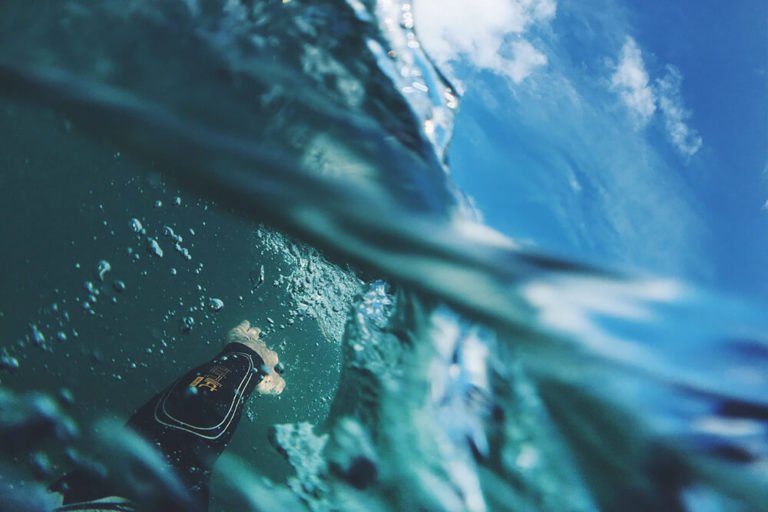What to Do When You Get Caught in a Current?

Open water scuba diving is fun and exciting, and gives you a unique chance to experience the underwater world in a way that’s simply not possible when snorkeling or diving without scuba equipment.
Scuba diving can also be dangerous if you are not prepared. That’s why open water scuba divers must become certified by an organization like PADI or a similar diving organization before you can dive in the open water.
Getting certified ensures that you are prepared for the hazards you may face. But even trained scuba divers may not know how to respond in every situation.
For example, what should you do if you are caught in a strong current? Let’s discuss some basic scuba diving safety tips you can use to ensure your safety if you are caught in a current.
1. SWIM TO A NEARBY OBJECT & TAKE SHELTER
If you experience an unexpected current at your dive site, you can mostly mitigate its effects by swimming to a nearby object and taking shelter.
An object such as a reef, a large stone, a wreck or any other such large, solid object will block most of the effects of the current. You can hang onto the object to prevent yourself from being pulled further away from the dive site.
After doing this, you can plan your next move. It may be best simply to surface and have your boat retrieve you, and find a different dive site if the current is very strong. If not, you may be able to turn your dive into a “drift dive.” In this type of dive, you simply let the current propel you as you explore the seafloor.
2. SWIM NEAR THE BOTTOM OF THE OCEAN FLOOR
If you cannot find an object to grab or take shelter from the current, you may want to swim downward to the bottom of the ocean floor. Naturally, this advice only applies when you are on a relatively shallow dive, and the floor is within easy reach.
In most cases, strong rip currents are less powerful near the ocean floor, so you may be able to swim out of the current by swimming near the bottom of the ocean floor.
Once you’ve done so, you’ll be able to determine whether you should attempt to return to your dive site, swim back to the shore, or surface for a pickup from your boat.
3. DON’T TRY TO FIGHT THE CURRENT
If you are caught in a sudden rip current that sweeps you away from your dive site and other divers in your party, it’s important that you never try to fight the current.
Even the fittest, strongest scuba diver can’t fight against a current that is more than 2-3 knots. This is far faster than you can hope to swim.
Instead of trying to fight the current, you should try to “ride it out.” Most rip currents do not maintain the same strength for very long. After a few minutes, you may find that the current has slowed to such an extent that you can swim out of it.
4. SWIM OUT OF THE CURRENT – RATHER THAN INTO IT
If you are trying to escape a rip current, you should not fight it – as mentioned above. Instead, you should try to swim out of it.
The strongest rip currents are typically quite narrow. If you can swim to the left, right or up or down, perpendicular to the current, you may be able to escape most of its effects and get back to your dive site.
5. RECOVER AFTER YOU ESCAPE FROM THE RIP CURRENT
After you have escaped from the current, it’s time to plan your next move and get back to safety. If you are diving with a boat, you should take out your DSMB and release it. Wait for about 5 meters below the surface for your boat to come and pick you up.
If you were diving without a boat, it’s time to head to the surface. You should fill your BCD (buoyancy control device) with air to maintain positive buoyancy. Begin swimming for shore, and attempting to signal for help.
The power of the current is likely to be lessened on the surface of the water. Remember to swim at an angle relative to the current to escape it. Maintain a steady pace as you continue to swim toward shore, and signal for help periodically.
Once you’ve reached the shore, make sure that you signal to your dive party and let them know that you are okay.
CURRENTS CAN BE SCARY, BUT THERE IS NO NEED TO PANIC – FOLLOW THESE TIPS
Even the most experienced scuba diver can get a bit nervous when they’re caught in a powerful current. But as long as you keep your wits about you and follow these safety tips, you’ll be able to ride out the current, escape it, and return to the surface or the shore safely.
For more information about dealing with rip currents and other scuba safety issues, we recommend consulting with a local scuba diving instructor near you! Whether you’re a beginner, an intermediate diver, or an expert, there is always more you can learn.
